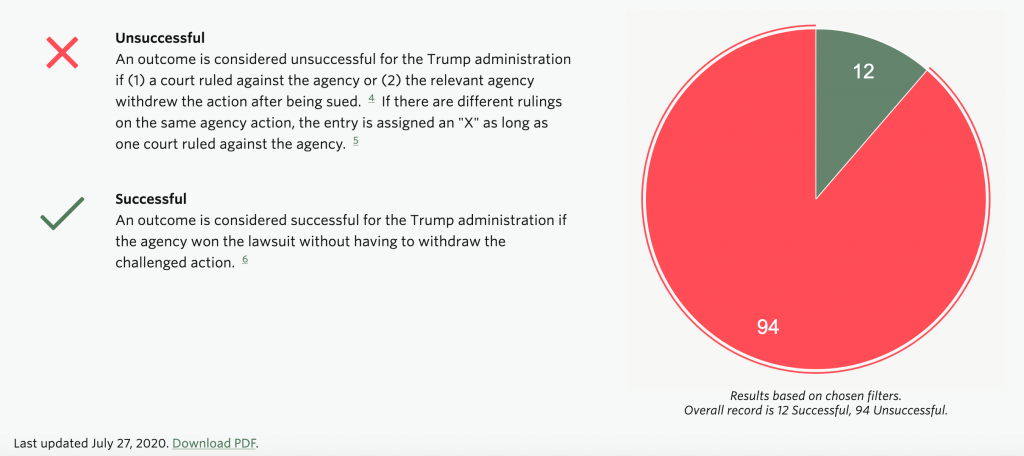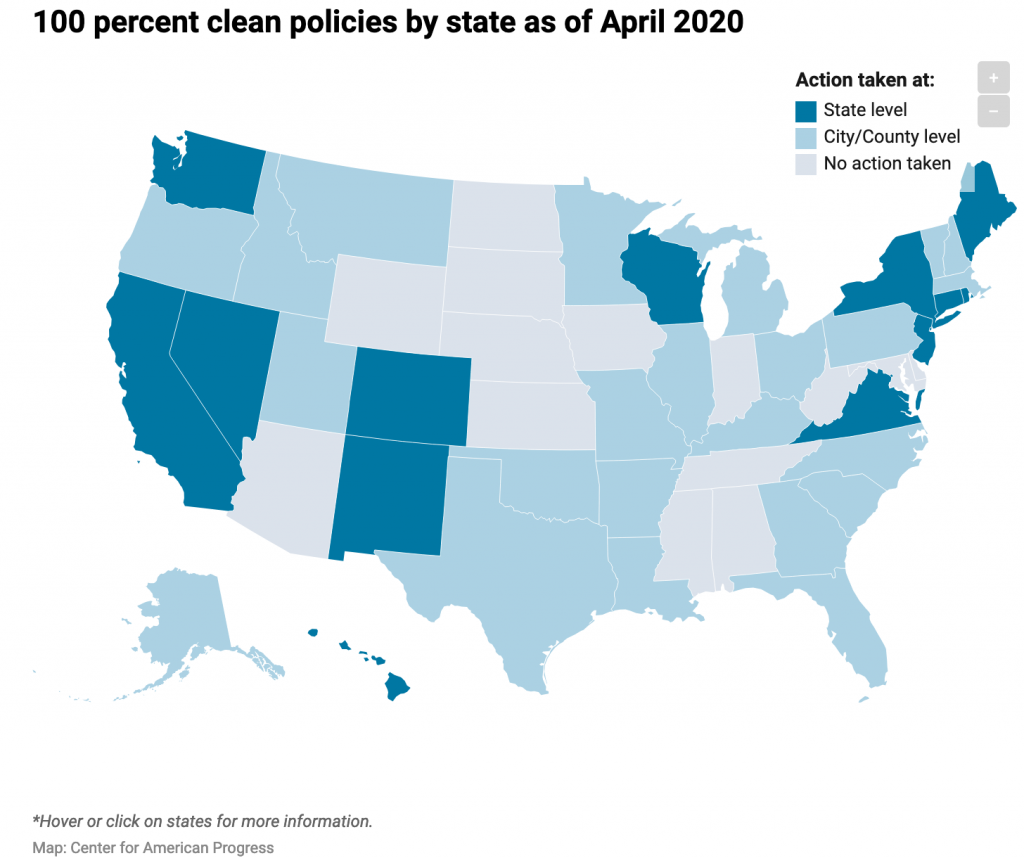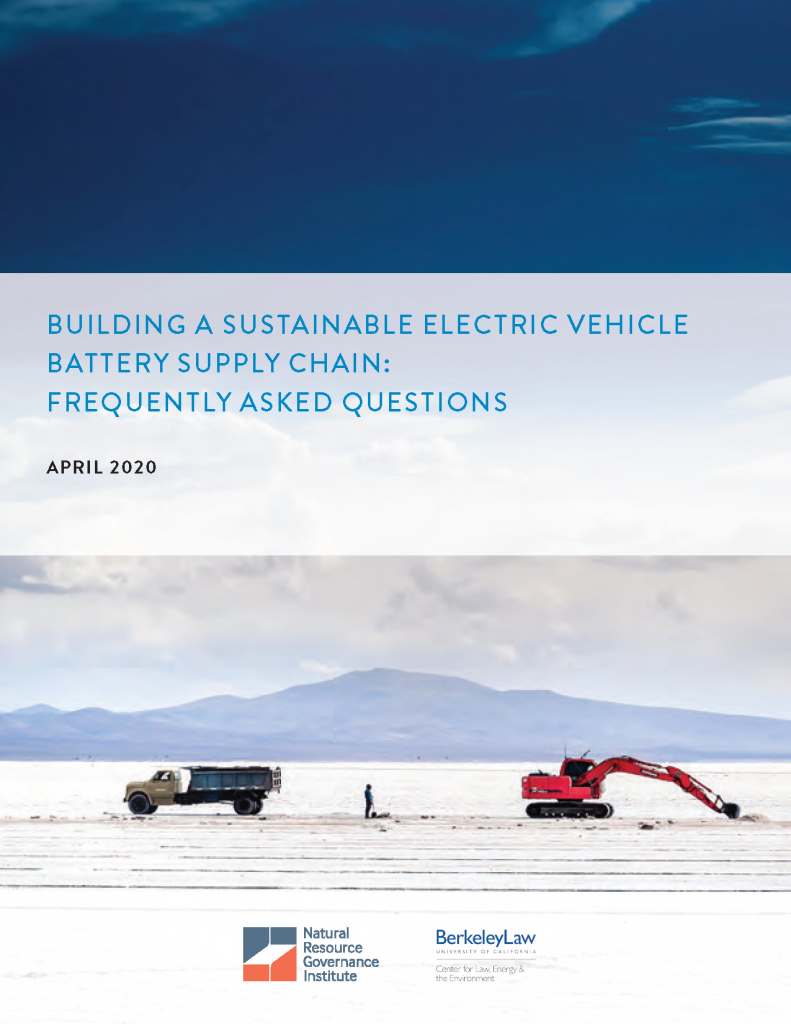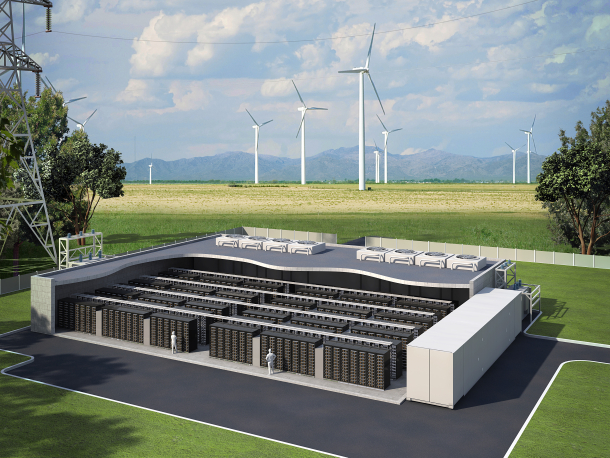On January 27, 2017, just one week after Trump’s inauguration, UC Berkeley Law’s Henderson Center for Social Justice held a daylong “Counter Inauguration,” featuring various panels in reaction to Trump’s victory. I spoke on an afternoon panel that day entitled “Monitoring the Environmental, Social and Governance Impacts of Business in the Trump Era” and offered my predictions on what the Trump years would bring for environmental law and policy.
I recently reviewed these predictions, three months out from the upcoming November election, to see how they measured up against the reality of Trump’s near-complete term in office. Bottom line: these predictions mostly tracked with what happened with Trump and his administration’s leaders, albeit with some steps I missed, some that never came to pass, and some positive outcomes for environmental protection.
First, I predicted the Trump Administration would follow through on the campaign pledges to boost fossil fuels in the following ways:
- Opening up public lands for more oil and gas extraction
- Slashing regulations that limit extraction and related pollution, such as the Clean Power Plan and methane rules
- Weakening fuel economy rules for passenger vehicles
- Financing more infrastructure that could boost automobile reliance (i.e. more highways and less transit)
These were all relatively predictable actions, and they all pretty much happened as predicted. On public lands and fossil fuels, Trump rolled back National Monument protection at Utah’s Bears Ears and Grand Staircase-Escalante, as well as streamlined permitting for oil and gas projects on public lands. On environmental rules in general, here is a list of 100 environmental regulations that the administration has tried to reverse. On vehicle fuel economy standards, here’s my article on EPA’s proposed rollback. And transit funding went from 70 percent of transportation grants under Obama to 30 percent under Trump, with the rest funding highways.
Second, I predicted that his administration would try to undermine clean technologies by:
- Weakening tax credits for renewables and electric vehicles
- Undoing federal renewable fuels program
- Revoking California’s ability to regulate tailpipe emissions
- Attempting to undermine California’s sovereignty to regulate greenhouse gases through legislation
- Cutting funding for high speed rail and urban transit
- Withdrawing from Paris agreement
On these predictions, I was correct on most accounts. The administration did weaken tax credits for renewables (both by not extending them or preventing them from decreasing over time, save for a recent one-year extension on wind energy as a budget compromise) and electric vehicles (by letting them expire and threatening to veto Democratic legislation that would have extended them in a recent budget bill). His EPA did revoke California’s waiver to issue tailpipe emission standards. And he famously withdrew from the Paris agreement (to take actual effect later this year) and has tried to cancel almost $1 billion in high speed rail funding in California.
But I was incorrect that the administration would pursue legislation to preempt California’s (and other states’) sovereignty to set their own climate change targets. There was little appetite in Congress to do so, though Trump’s Justice Department did seek unsuccessfully to declare California’s cap-and-trade deal with Quebec to be unconstitutional. And his record on renewable fuels is more mixed but did deliver some gains to corn-based ethanol producers, though the environmental benefits are suspect with this type of biofuel. I also failed to predict the administration’s efforts to impose tariffs on foreign solar PV panels and wind turbines, which slowed those industries somewhat.
Finally, I predicted some possible bright spots for the environment in the Trump years, much of which did occur:
- Clean tech generally has bipartisan support in congress
- Infrastructure spending in general could be negotiated to benefit non-automobile investments
- Lawyers can stop or delay a lot of administrative action on regulations
- A shift will happen now to state and subnational action on climate, which probably needed to happen anyway
Sure enough, clean technology, particularly solar PV, wind and batteries, has continued to increase in the Trump years, though not at the same pace as under Obama due to the policy headwinds. But infrastructure spending has definitely favored automobile interests, as noted above.
But more importantly, two critical predictions did come to pass. First, attorneys have successfully stopped most administrative rollbacks. In fact, the administration has an abysmal record defending its regulatory actions in court. As NYU Law’s Institute of Policy Integrity has documented, the administration has lost 94 cases in court and won only 12 to date, as tracked in this chart:

And perhaps more importantly, the lack of federal climate action has moved the spotlight to state and local governments, which often have significant sovereignty to enact aggressive policies that add up to serious national climate action. Take renewable energy, for example, per the Center for American Progress, with this map of states and municipal governments that have enacted 100% clean electricity standards:

And on clean vehicle standards, 13 states plus the District of Columbia now follow California’s aggressive zero-emission vehicle standards, representing about 30 percent of the nation’s auto market.
As a result, in many ways, environmental law and climate action appears to have survived the Trump term in office mostly intact, despite losing progress and facing some setbacks on key issues. Most of the regulatory actions can be reversed by a new administration, while Congressional action during the Trump years was relatively minimal in scope. Meanwhile, the counter-reaction to Trump spurred some significant policy wins at the state and local level.
But while one term is perhaps survivable for environmental law and climate progress, a second one could paint a completely different picture. So the stakes certainly remain high this November.
California law under SB 100 (De León, 2018) requires that our electricity system run on 100% carbon-free power by 2045. That means a significant deployment of energy storage resources, like batteries, to capture surplus renewable power from the sun and wind for dispatch during dark and windless times.
While passing this law was a milestone, actually achieving this target will require siting and permitting major clean energy facilities. And perhaps no better land is appropriate for these facilities than at existing fossil fuel plants. These plants are on already-industrialized land with access to transmission lines. Converting them to energy storage facilities is a double-win: it offers a phase out of fossil fuels, while improving the air quality (and often the aesthetics) of the surrounding area.
So that’s why it’s frustrating to see one such proposed conversion to battery storage — the Moss Landing power plant battery energy storage project — potentially held up for months now by local opposition. The Monterey County Planning Commission will consider the project at its July 29th hearing.

The proposed project involves a 1,200-megawatt (MW) battery energy storage system, fit into the existing industrial footprint of the Moss Landing power plant in four two-story buildings, along with associated infrastructure (substations and inverters/converters). It will also replace existing lattice transmission towers with monopoles (staff report available here).
Most importantly, the goal of the project is to store renewable energy from the sun and wind to help California decarbonize its electricity grid. For this reason, Pacific Gas & Electric (PG&E, the local utility) selected the project and brought it to the California Public Utilities Commission for approval, with a condition that the project reach commercial operation by July 18, 2021 (PG&E advice letter here).
But a good proposal to support needed climate policy is not always enough in California. Permitting any industrial project comes with challenges and opposition, most notably compliance with environmental review under the California Environmental Quality Act (CEQA).
In this case, a review of the project under CEQA by the county revealed no significant impacts on the myriad study areas, including air quality, biological resources, water, traffic, cultural resources, and others; provided the developer implement appropriate mitigation measures. However, the developer ended up going beyond the county’s recommendations by committing to a dialogue process to identify additional mitigation measures to protect migratory birds. In short, the developer agreed to go above and beyond what CEQA requires.
Furthermore, in collaborating with the National Audubon Society and Monterey Audubon, the developer agreed not to include new transmission poles and high-voltage wires until after 2020, at which point they will conduct final design in consultation with those nonprofits. The company further committed to addressing bird safety issues in that process, including consideration of undergrounding high-voltage transmission wires.
Ultimately, the clean energy nature of the project, the county’s preparation of an environmental review document that follows CEQA, and this additional commitment to address bird safety issues were enough to gain the support of Audubon and the Sierra Club. The project appeared to face relatively easy sailing to a permit, but the planning commission delayed considering it at its July 8th meeting so that the environmental review document could be revised to clarify transmission wire placement associated with the project. Hopefully, the commission approves the project on July 29th, and no one appeals it to the Monterey County Board of Supervisors.
If California can’t allow relatively straightforward permitting of energy storage facilities at existing power plants with minimal anticipated impacts, where can they go? Not only will clean tech companies shy away from investing in California, potentially driving up costs from lack of competition, but these eyesore power plants may take longer to decommission. In the case of Moss Landing, the power plant has 500-foot dual smokestacks visible through Monterey Bay, a source of visual blight and air pollution in an otherwise unique marine and coastal environment. This battery storage project could help facilitate this decommissioning sooner rather than later, while embodying precisely the critical energy storage deployment California needs to achieve a decarbonized future.
Building a low-carbon economy will rely on a transition from gasoline-powered automobiles to electric vehicles, which will require a significant increase in production of component minerals. Extracting and refining these minerals, like cobalt and lithium, can often entail challenges related to governance, human rights, and environmental quality in host countries.
To help launch a forthcoming CLEE and Natural Resource Governance Institute (NRGI) report on this topic, join our upcoming webinar on Thursday, July 23rd, at 9am PT/noon ET/6pm CET. Panelists will discuss mechanisms to address sustainability concerns and build a better supply chain for this key emission reduction technology, as well as summarize findings from the new report.
Speakers include:
- Patrick Heller, Senior Visiting Fellow, Center for Law, Energy & the Environment (CLEE) & Advisor, Natural Resource Governance Institute (NRGI)
- Michael Maten, Automotive Public Policy, Electrification, Portfolio Planning and Strategy, General Motors
- Daniel Mulé, Senior Policy Advisor for Tax and Extractive Industries, Oxfam
- Payal Sampat, Mining Program Director, Earthworks
You can register here and read our recent FAQ on EV batteries for more information on current supply chain impacts on human rights, climate change and the local environments.

The global transition from fossil fuel-powered vehicles to battery electric vehicles (EVs) will require the production of hundreds of millions of batteries. This massive deployment frequently raises questions from the general public and critics alike about the sustainability of the battery supply chain, from mining impacts to vehicle carbon emissions.
Join me and Berkeley Law’s Center for Law, Energy & the Environment’s Patrick Heller and Ted Lamm today at noon Pacific Time for a discussion and Q&A session on the road to a sustainable EV battery supply chain.
You can register for this free event and download our recent FAQ on EV battery supply chains. Hope you can join!

I began working on climate change law and policy on January 20, 2009, the day I joined Berkeley Law, which was coincidentally Barack Obama’s Inauguration Day. So it’s been a full decade for me focusing exclusively on this subject (I focused on related land use and transit issues prior to 2009), roughly coinciding with the 2010s now coming to a close.
As we mark the end of this decade, two things stand out: remarkable progress reducing the price and deploying critical clean technologies, and dispiriting failure to reduce overall greenhouse gas emissions, with more severe climate impacts happening each year.
I noted some of these trends in a foreword to “Climate Change Law in the Asia Pacific” from Berkeley Law, which features articles from scholars in places like Japan, Korea, and Taiwan, as well as California.
To summarize the good news on clean technology:
- From 2009 to 2017, the levelized costs for utility-scale solar photovoltaic dropped 86 percent;
- Wind power levelized costs dropped 67 percent from 2009-2017; and
- Lithium ion battery prices (central to electric vehicles and grid energy storage) have dropped 85 percent from 2010 to 2018.
This progress is the key reason for optimism on climate change. With the price decreases, support for deployment has increased across the political spectrum and allowed for some remarkable success stories on emissions reductions, such as California’s ability to achieve its 2020 carbon goals four years earlier, due primarily to renewable energy deployment.
But despite the progress, we have this sobering data:
- Carbon parts per million have increased from 385 in 2009 to 411 (and counting).
And unsurprisingly, the bill is now coming due. This decade has brought some of the predicted severe climate impacts, such as unprecedented wildfires, droughts, extreme rain events and hurricanes, and warming oceans.
On the positive side, the extreme weather has helped shift public opinion in favor of climate action. But it’s come at a significant cost to human life, happiness, and ecosystems.
Hopefully in the 2020s we’ll see the widespread deployment of clean technologies and other climate-smart practices that we need to stabilize and reduce emissions. And while climate impacts will inevitably worsen, perhaps our ability to withstand them will improve, such as through electricity grid resilience in the face of wildfires and using natural infrastructure to lessen storm surges and flooding.
And to make any of these positives happen, we will need smart policies and public support and political leaders to enact them. I’ve had the good fortune to work on climate policy now for over a decade, and as the 2020s dawn, much work remains.
The dark winter months are a reminder that critical renewable resources like solar PV won’t be available to keep our electricity clean. And if the wind isn’t blowing, wind power is unavailable as well to meet demand. Absent baseload renewables like geothermal power, how do we achieve a 100% carbon-free in the dark, still winter time?
The answer is bulk — or seasonal — energy storage. This means massive energy storage facilities that can capture surplus renewable power like solar PV in the summer months, and store it for months until the winter.

Not many technologies can achieve this mass, seasonal storage, but Utility Dive offers a helpful list, summarized here:
- Pumped Hydro: this relatively common technology involves pumping water uphill with cheap surplus electricity and then releasing it downhill to generate power when needed. It’s been in use since the 1890s, and by the end of 2017, the US had about 22 gigawatts installed.
- Compressed Air Energy Storage: this technology involves pumping air into a confined space, like a container or underground cavern, then releasing the pressure to generate electricity when needed. It’s a capital-intensive system constrained by geography. To date, I only know of two facilities in operation, although more are in the planning stages.
- Lithium-ion battery banks: with falling battery prices, these have been a “go-to” recently for energy storage. But it’s unclear if we can produce and deploy enough batteries to store power for months at grid-scale, particularly since many of these batteries will be needed for electric vehicles.
- Other batteries: By the end of 2017, the U.S. had 708 megawatts of large-scale battery capacity other than lithium, according to the U.S. Energy Information Administration.
- Gravity-based systems: more developers are experimenting with gravity-based systems, such as trains that power uphill and then go back downhill to release energy when needed, as I blogged about a few years ago. As another example, Switzerland-based Energy Vault unveiled a crane mounted on a steel tower 300 feet high, which hoists 35 metric ton concrete “bricks” into stacks. To discharge, the crane lowers the bricks to the ground.
- Hydrogen: liquid hydrogen gas can be a form of energy storage, if it’s produced with surplus renewable power. It can be stored without degrading and used to power a fuel cell or gas turbine (or to power fuel cell vehicles like hydrogen trucks).
Other technologies may exist or be in the planning stages to overcome this seasonal challenge with providing 100% carbon-free power all year. As more jurisdictions seek to meet this clean power goal, these bulk storage technologies will become critical in the near future.
I’ll be a guest on KPCC radio’s AirTalk program today at 10:20am, discussing the decision by the Los Angeles Department of Water and Power, at the urging of Mayor Garcetti, to phase out natural gas plants along the coast rather than rebuild them.
The plants will be replaced by renewable energy sources and energy storage, among other clean resources. Some business groups are concerned about the economic impacts on ratepayers, including the other guest, Stuart Waldman, president of the Valley Industry and Commerce Association.
It should be a lively discussion, so I hope you can tune in and ask questions!
California has officially launched its “net zero” requirements for new homes, which will mandate rooftop solar or the equivalent for new residential construction. Marketplace on NPR covered the story, including an interview with me:
As I blogged previously, the edict comes not without controversy, particularly from economists convinced that utility-scale solar PV is more cost-effective than the rooftop, distributed type. Still, the mandate has flexibility along these lines and promotes other cost-effective forms of distributed energy, such as community solar and on-site energy storage.
And as California pioneers this approach, we’ll soon have data on how effective it will be, potentially as a model (or lesson) for other jurisdictions contemplating the adoption of similar programs.
Rural America has been falling behind urban America for decades, in terms of economic productivity and population growth. The worsening divide has manifested in cultural and political disruption nationwide. What role can climate policy play to help repair the inequity and hollowing out of our rural places?
My colleague Dan Farber describes the stark situation in Legal Planet:
According to Brookings researchers, the 53 largest metros account for over 95% of the nation’s population growth and 73% of the employment gains since 2010. Rural areas—those with no metros over 250,000 –are losing population and account for a declining share of the national economy. In other words, Brooking says, “9 percent of the population lives in smaller metros that are stagnant or slipping as a group and another 14 percent in rural places that are almost all declining.” It’s not hard to see why people are unhappy.
He then cites some of the ways that climate and environmental policy could help. First, rural areas will be disproportionately affected by a changing climate, particularly to agriculture. So they may be amenable to policies that address these impacts. Second, while they are not as affected by air pollution, drinking water contamination is a factor. So policies that bolster safe drinking water could be winners.
Finally, and perhaps most importantly, clean energy policies could usher in a “Green New Deal” for rural America that boosts local jobs and economic development. That means jobs installing, constructing and managing renewable energy facilities, both small- and large-scale, plus related energy storage facilities. Energy retrofits of existing buildings can boost local contractor opportunities. Zero-emission vehicle technologies like battery electrics mean people can fuel their vehicles with local clean electricity instead of with the global commodity of oil. Those oil and gas purchases otherwise enrich far-off corporations and nations, representing a failure to circulate and invest that money locally. Natural and working landscapes in rural areas could also potentially receive carbon offset funding to be preserved as carbon sinks.
It would be a winning climate recipe that could also have the benefit of addressing the extreme inequality in the country. The politics, economy and global climate could all come out ahead with a Green New Deal.
 The critics are out for California’s groundbreaking climate and energy goals. Cal Matters (and former Sacramento Bee) columnist Dan Walters criticizes the state’s new 100% renewable energy and carbon neutrality goals by 2045:
The critics are out for California’s groundbreaking climate and energy goals. Cal Matters (and former Sacramento Bee) columnist Dan Walters criticizes the state’s new 100% renewable energy and carbon neutrality goals by 2045:
It’s theoretically possible to build enough solar and windmill farms to [achieve a 100% greenhouse gas-free grid], albeit at immense cost, but there’s a corollary problem. They mostly generate during daylight hours, so having their power available 24 hours a day would require huge amounts of storage, presumably in massive battery banks.
Battery technology hasn’t advanced to that stage yet, at least at a viable cost. After Brown signed the 2045 legislation, Moody’s, the big credit rating organization, called it a “credit negative” for the state’s electrical utilities, citing battery storage capacity.
Walters fails to acknowledge here that “energy storage” to capture surplus renewables includes a diverse array of technologies beyond just batteries. Furthermore, with the carbon-free target date of 2045 still a generation away, industry has plenty of time to innovate in response to this challenge. We’ve already seen battery prices decline about 80% in 10 years. So why use today’s numbers to criticize a critical long-term mandate?
Walters then attacks California’s zero-emission vehicle (ZEV) goals:
There are only about 200,000 ZEVs on the road now, so replacing all gasoline- and diesel-fueled cars at $30,000 each by 2045 would cost California motorists (and/or taxpayers) about a trillion dollars, or an average of $37 billion a year.
Again, Walters refuses to assume any cost decreases in the price of ZEVs by 2045, or the availability of inexpensive used vehicles in the meantime. This flies in the face of price trends to date. Walters also neglects to mention the fuel and maintenance savings from these vehicles.
Finally, he criticizes the push for electrification of transportation based on how much more power the state will need to deliver:
Driving 100 miles in a ZEV consumes 30 kilowatt-hours of electric power, according to the federal government. Therefore, assuming they were still traveling 330 billion miles each year, recharging 30 million ZEVs would expand annual electric power consumption from 300 terawatt-hours to at least 400, and that extra juice also would have to come from solar, wind and other renewable resources.
Moreover, since the ZEVs would be mostly recharged at night, the carbon-free electrical grid would need even more battery storage to keep them running.
Fun numbers, indeed.
Walters omits some key details. First, the state also has a goal of increasing energy efficiency, including a doubling of efficiency in existing buildings by 2030, which would reduce energy demand overall. Second, state leaders are trying to reduce driving miles per capita by investing in more transit, walking and biking infrastructure, while attempting to build more homes close to jobs and transit. If successful by 2045, driving miles would decrease, along with projected energy demand. Finally, state regulators are pushing for electricity rates that will encourage more daytime charging, to avoid the problem Walters cites.
Overall, Walters’ entire analysis fails to factor in the cost of inaction. What about the public health impacts of more pollution? What about the cost of addressing climate impacts, such as more fires, sea level rise, and droughts?
Walters raises some legitimate questions, but his analysis in response is selective and incomplete.


